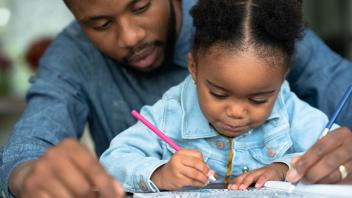Overview
First, scribbling and drawing
Most children begin their writing career by scribbling and drawing. Grasping the crayon or pencil with a full fist, a young scribbling child is exploring with space and form. He is creating a permanent record of his ideas and thoughts. These first scribbles can be proud accomplishments! Thick markers, crayons, and unlined paper are good writer’s tools for this stage.
Next, letter-like forms and shapes
At this stage of writing development, children begin to understand that writers use symbols to convey their meaning. Writing begins to include shapes (circles, squares) and other figures. A child will often write something and ask, “What does this say?”
Pre-K children start drawing letter-like shapes in a large circular motion as a playful activity. Often, a young child’s first letters are drawn by accident and then identified by the child or parent.
Kids at this age will form letters to represent written language for meaningful words like their names or phrases such as “I love you.”
Understanding why we write
When engaging in writing, young children often mirror what they see around them; adults and older children writing lists, notes, text messaging. They are observing the way writing is used in our everyday lives.
Looking at writing
See samples of real writing from pre-K children in our interactive resource, Looking at Writing.
Try these writing ideas at home
Writing as play
Keep markers, pencils, and crayons available at home. Children develop skills that prepare them for writing through their normal play — like drawing, painting, and tracing objects. This kind of play helps prepare the brain and the muscles for holding a pencil and forming written words.
This is my name!
Help them learn to write their name. This is an empowering experience, and allows them to begin to identify themselves as writers.
Author’s chair
Identify a special “author’s chair” in your home. That’s where your child can sit and share out loud something she has drawn, scribbled, or written. Be an enthusiastic listener! This shows your child that others want to hear about her thoughts and ideas.
Write together
Involve them in your writing activities. Make a shopping list together and point out the words that start with the same letter as the child’s name.
Reading supports writing
Read books together! Early and frequent exposure to letters, sounds, words, and stories helps kids learn to read and write.
Talk about vivid words
As you read to your children, point out things the book author did to make the book so fun to read. “Wow! Listen to how the author describes the ocean. Don’t those words make you feel like you’re back jumping over waves?”
Multisensory writing
Once children start learning letters, you can practice writing them on paper, in the air, or in sand or snow. These tactile experiences help them feel the shape and motion of the letter.
Add captions
As your child begins to write letters, caption what they’ve written. Ask your child, “What does this say?” Write their words under their writing. This helps them learn more about letters and words.
Dictation
Write down what your child says — it’s a simple way to model why written language is important. Try it after a family adventure, an exciting event, or a shared book experience. It can be as simple as writing down a favorite part of a movie or book or recording what was for dessert that night. Have your child sit next to you or watch you write. Your child’s watching will help her become aware of the “rules” of writing, including capitalization, spacing between words, and punctuation. Keep the dictated sentences short, and use your best handwriting! When you’re done writing, encourage your child to re-read the sentences along with you.
Model everyday writing
Show your children that you write too. Let your children see you writing thank you notes, composing an e-mail, or communicating with your child’s school.
Letting your children scribble gets them ready to read and write
This video is from Home Reading Helper, a resource for parents to elevate children’s reading at home provided by Read Charlotte . Find more video, parent activities, printables, and other resources at Home Reading Helper .
More writing resources
- Developing Writing and Spelling at Home (Pre-K) (In English and Spanish)
- Looking at writing: An emergent writer
- How Writing Develops
- When Writing Is Hard (In English and Spanish)
